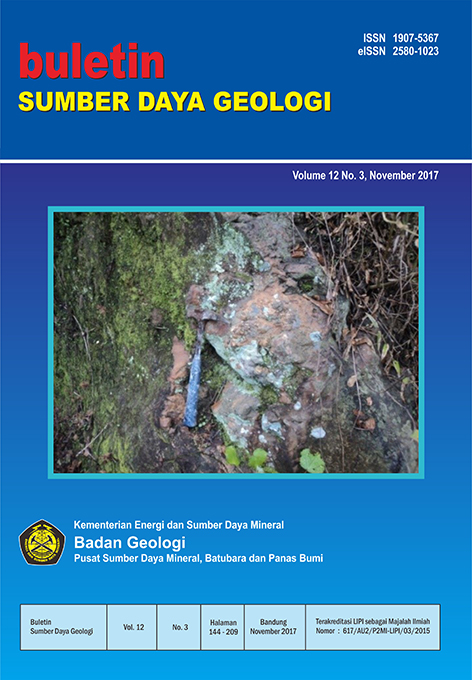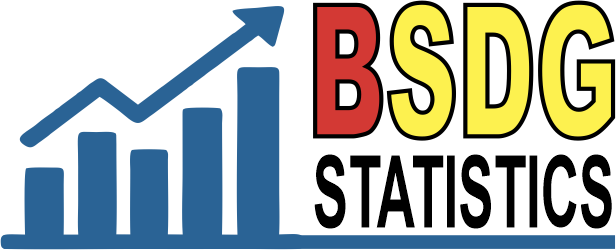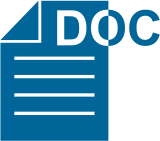GEOKIMIA BATUAN INDUK HIDROKARBON FORMASI CINAMBO DI DAERAH SUMEDANG, JAWA BARAT
Abstract
Penelitian geokimia batulempung telah dilakukan pada Formasi Cinambo di wilayah Kabupaten Sumedang, dengan tujuan untuk mengetahui karakter batuan induk dan biomarker ekstrak batuan serta hubungannya dengan rembesan minyak di daerah Majalengka. Metode yang dilakukan adalah penelitian lapangan dan analisis laboratorium yang meliputi analisis Total Organic Carbon (TOC), pirolisis Rock Eval dan Gas Chromatography Mass Spectrometry (GCMS). Penelitian lapangan meliputi pengamatan litostratigrafi Formasi Cinambo pada Sungai Cinambo dan Cisaar serta pengambilan percontoh untuk analisis laboratorium. Hasil analisis dari 16 percontoh batulempung Formasi Cinambo menunjukkan nilai TOC 0,32-1,47% yang berpotensi rendah hingga baik untuk membentuk hidrokarbon. Material organik di daerah penelitian termasuk dalam kerogen tipe III, berdasarkan diagram TOC vs Hydrogen Index (HI). Tingkat kematangan 4 percontoh mengindikasikan kondisi belum matang (immature), 6 percontoh termasuk matang dan 6 percontoh lainnya tidak terdeteksi. Berdasarkan nilai HI, yaitu 2-90, dapat menghasilkan gas dengan kuantitas kecil. Hasil biomarker ekstrak batuan Formasi Cinambo menunjukkan tidak ada korelasi positif dengan rembesan minyak di daerah Majalengka.
Downloads
References
Baskin, D. K. (1997). Atomic H/C Ratio of Kerogen as a an Estimate of Thermal Maturity and Organic Matter Conversion. American Association of Petroleum Geologist Bull, 81, 1437–1450.
Djuri, M. (1995). Peta Geologi Lembar Arjowinangun, Jawa, skala 1: 100.000. Pusat Penelitian dan Pengembangan Geologi.
Hidayat, R. dan F. (2007). Inventarisasi Kandungan Minyak dalam Batuan Daerah Kedungjati, Kabupaten Semarang, Provinsi Jawa Tengah. In
Prosiding Pemaparan Hasil Kegiatan Lapangan dan Non Lapangan Pusat Sumberdaya Geologi (p. 13 h).
Hunt, J. M. (1979). Petroleum geochemistry and geology. A Series of Books in Geology, (Dl), 617. https://doi.org/10.1016/S0009-2541 (96)00131-3
Mukhopadhyay, P. K., Wade J. A, Gruge, M. A. (1995). Organic facies and maturation of Jurassic/Cretaceous rock, and possible oil-source rock correlation based on pirolysis of asphaltenes, Scotian Basin Canada. Org. Geochem, vol.22, no, 43–55.
Panggabean, H., & Heryanto, R. (2009). An appraisal for the petroleum source rocks on oil seep and rock samples of the Tertiary Seblat and Lemau Formations, Bengkulu Basin. Indonesian Journal on Geoscience, 4(1), 43–55. Retrieved from http://ijog.bgl.esdm.go.id.
Pramono, W. dan Amijaya, H. (n.d.). Karakteristik geokimia rembesan minyak bumi di daerah Bantal, Kecamatan Bancak, Semarang, Jawa Tengah. In Prosiding Pertemuan Ilmiah Tahunan IAGI ke 37, Bandung.
Praptisih. (2016). Karakteristik batuan induk hidrokarbon dan hubungannya dengan rembesan minyak di lapangan Cipluk, Kabupaten Kendal, Provinsi Jawa Tengah. Buletin Sumberdaya Geologi Dan Mineral, 11, 27–40.
Praptisih dan Kamtono. (2016). Potensi Batuan Induk Hidrokarbon pada Formasi Cinambo di Daerah Majalengka, Jawa Barat in the Majalengka Area, West Java (Vol. 17).
Price, P. L., O’Sullivan, T. and Alexander, R. (1987). The nature and occurence of oil in Seram, Indonesia. In Procceding of the Indonesian Petroleum Association. Sixteenth Annual Convention, Indonesian Petroleum Association, Jakarta, Indonesia. (pp. 141–73).
Rad, F. K. (1984). Quick Look Source Rock Evaluation by Pyrolysis Technique, 2(Volume 2), 1984.
Waples, D. W. (1985). Geochemistry in petroleum exploration. D. Reidel Publishing Company. https://doi.org/10.1007/978-94-009-5436-6.
Waples, D. W., & , Machihara, T. (1991). Biomarkers for geologists. A practical guide to the application of steranes and triterpanes in petroleum geology. AAPG Methods in Exploration, 9(9), 91. Retrieved from http://search.datapages.com/data/specpubs/me9.htm.
Copyright (c) 2017 Buletin Sumber Daya Geologi

This work is licensed under a Creative Commons Attribution-NonCommercial-ShareAlike 4.0 International License.
Authors whose manuscripts are published agree to the following terms:
The publication rights of all journal manuscript materials published on the Buletin Sumber Daya Geologi website are held by the editorial board with the knowledge of the author (moral rights remain with the manuscript’s author).
The formal legal provisions for access to digital articles in this electronic journal are subject to the terms of the Creative Commons Attribution-ShareAlike (CC BY-SA) license. This means that Buletin Sumber Daya Geologi has the right to store, convert media/formats, manage in the form of a database, maintain, and publish the article without requesting permission from the author, as long as the author’s name is cited as the copyright holder.
Manuscripts published in both print and electronic formats are open access for educational, research, investigative, and library purposes. Beyond these purposes, the editorial board is not responsible for any violations of copyright law.















